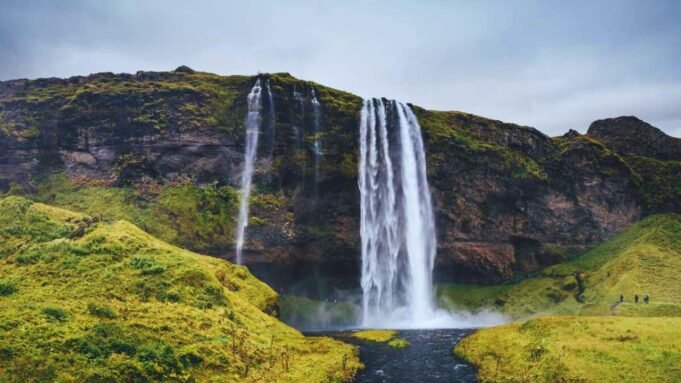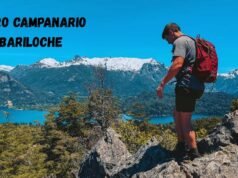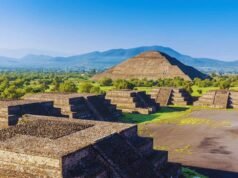Tucked along Iceland’s famed South Coast, Seljalandsfoss is more than just a beautiful waterfall—it’s a fully immersive experience that puts you right behind a curtain of cascading water. With its dramatic 60-meter plunge, lush surroundings.
The rare opportunity to walk directly behind the waterfall, Seljalandsfoss, has become a must-visit for travelers seeking both natural beauty and adventure. As one of Iceland’s most photographed sites, it offers not just a visual treat, but a deep connection to the country’s raw geological forces and mythic landscapes.
Location and Accessibility
Seljalandsfoss is located along Iceland’s Ring Road (Route 1), the country’s primary highway that loops around the island, making it easily accessible for most travelers. It’s approximately a two-hour drive from Reykjavik, Iceland’s capital, and about 60 kilometers west of the coastal town of Vík í Mýrdal.
The waterfall is marked with signs, and visitors will find a large parking area just a short walk from the base of the falls. Tour buses frequently stop here, and it’s included in many guided tours along the South Coast. The proximity to other major natural attractions makes Seljalandsfoss a convenient and rewarding stop on any Icelandic road trip.
Geological and Natural Features
Seljalandsfoss is part of the Seljalands River, which originates from the Eyjafjallajökull glacier—infamous for its 2010 volcanic eruption that disrupted air travel across Europe. The waterfall plunges from a cliff that was once a sea cliff, created thousands of years ago when the Atlantic Ocean reached further inland.
Over time, as the coastline receded and glacial rivers carved out valleys, waterfalls like Seljalandsfoss emerged along the exposed escarpments. The falls cascade down in a narrow, shimmering stream that forms a shallow pool surrounded by moss-draped rocks and rolling green hills in summer, or ice-sculpted ledges in winter.
Seljalandsfoss Horizons
The horizons surrounding Seljalandsfoss offer some of the most breathtaking views in all of Iceland. As the waterfall plunges from a dramatic cliff, visitors are treated to sweeping panoramas of the South Coast’s vast plains, distant mountains, and glacial rivers.
Whether you’re facing the waterfall head-on or standing behind its veil of mist, the open skies and expansive fields create a sense of endless space. At sunrise or sunset, the horizon glows with brilliant hues, making Seljalandsfoss a dream destination for photographers and nature lovers alike.
Seljalandsfoss Waterfall Iceland
Seljalandsfoss is one of Iceland’s most iconic and easily recognizable waterfalls, drawing visitors from around the world. Located just off the Ring Road in the South Coast region, it plunges 60 meters from an ancient sea cliff fed by the glacier-capped Eyjafjallajökull volcano.
Its most famous feature is the footpath that allows you to walk behind the falls for a unique and exhilarating perspective. With its cinematic beauty and accessible location, Seljalandsfoss is a must-see stop for anyone traveling through Iceland.
Seljalandsfoss Waterfall Hike
The Seljalandsfoss waterfall hike is a short but unforgettable adventure that allows visitors to experience the power and beauty of the falls up close. The main path leads from the parking area to the base of the waterfall and continues behind the cascade through a natural cave-like opening.
Though the hike is not long—typically taking 15 to 30 minutes—it can be slippery and wet due to constant mist. Waterproof gear and sturdy shoes are recommended. For the more adventurous, additional trails lead toward the nearby hidden waterfall, Gljúfrabúi, enhancing the overall hiking experience.
Related: Best Waterfalls Near Portland, Oregon
The Unique Behind-the-Waterfall Experience
What sets Seljalandsfoss apart from other waterfalls in Iceland is the footpath that loops behind the falls, offering visitors a rare, 360-degree view. The path leads through a natural cave carved into the cliffside, giving you the surreal sensation of being enclosed behind a translucent veil of water.
From behind the waterfall, you can witness the interplay of light, water, and sound in a truly magical setting. The mist can be intense, especially on windy days, so waterproof clothing and camera protection are essential. The rocks can also be slippery, so sturdy footwear with good grip is recommended. This perspective allows for breathtaking photography, especially during sunset when the light bathes the falls in gold and pink hues.
When is the Best Time to Visit Seljalandsfoss?
Seljalandsfoss can be visited year-round, but the experience varies dramatically by season. In summer (June through August), the area is bursting with life—vibrant green moss, blooming wildflowers, and long daylight hours allow for extended exploration and ideal photo conditions.
The path behind the waterfall is usually open and accessible, offering the full immersive experience. In contrast, winter (November through March) transforms the waterfall into a frozen wonderland, with icicles hanging from the cliffs and snow blanketing the surrounding fields.
The path behind the waterfall is often closed due to safety concerns, but the frozen spectacle is equally enchanting. Spring and fall offer fewer crowds and mild conditions, making them ideal for those seeking a more serene visit.
Nearby Attractions of Seljalandsfoss

Seljalandsfoss is just the beginning of a region filled with other natural marvels. A short walk north leads to Gljúfrabúi, a hidden waterfall partially concealed behind a narrow cliff opening. To reach it, visitors must wade through a shallow stream and enter a small canyon, where the falls cascade into a mossy chamber—offering a mystical, secluded atmosphere.
Just a short walk away is Gljúfrabúi, a lesser-known but equally magical waterfall hidden behind a narrow cliff opening. You’ll need to wade through a shallow stream to see it up close, but the reward is worth the effort.
Other notable nearby sites include:
- Skógafoss, a massive and powerful waterfall 30 minutes away.
- Seljavallalaug, one of Iceland’s oldest geothermal pools nestled in a quiet valley.
- Eyjafjallajökull Volcano Visitor Centre, which offers insight into the 2010 eruption that disrupted global air travel.
These destinations make Seljalandsfoss part of an incredible day trip itinerary.
READ: The 25 Most Stunning Waterfalls in Northern California
Cultural and Historical Significance
Beyond its natural allure, Seljalandsfoss holds a place in Icelandic culture and folklore. The region is steeped in tales of huldufólk—hidden people or elves believed to dwell in rocks and caves. Local legends suggest that cliffs around the falls are home to these mystical beings.
The waterfall has also gained fame through various media appearances. It has been featured in music videos, travel documentaries, and films, including a scene in Justin Bieber’s “I’ll Show You.” Its cinematic appeal has helped boost Iceland’s global image as a land of otherworldly beauty.
The connection to Eyjafjallajökull glacier also lends Seljalandsfoss a deeper historical resonance, linking it to the powerful geological forces that continue to shape Iceland.
Practical Information
Seljalandsfoss is a free-to-visit natural site, though parking in the adjacent lot costs a small fee (around 700 ISK). The area is generally well-maintained with walking paths, signage, and seasonal facilities. Public restrooms are available near the parking lot, and during the peak summer months, a small café or food truck may operate nearby.
There is no need for a guide, but those seeking context or company may prefer a group tour. When visiting, especially during colder months, bring waterproof gear, layers, gloves, and a flashlight if you plan to explore nearby areas in low light. Photography enthusiasts should bring a wide-angle lens, a tripod, and a waterproof camera bag for the best results.
- Parking: Available for a small fee.
- Entrance Fee: None.
- Facilities: Restrooms, a small café during peak seasons.
- Tips: Bring waterproof gear, especially if planning to walk behind the falls. A tripod is recommended for photographers.
Because of its location on the main tourist route, Seljalandsfoss is accessible year-round, though conditions can vary in winter.
What makes Seljalandsfoss Different From Other Waterfalls in Iceland?
Seljalandsfoss stands out because it offers visitors the rare opportunity to walk behind the waterfall, allowing for a 360-degree view of its cascading waters. Most waterfalls are admired from the front or side, but Seljalandsfoss’s unique cliff formation and accessible footpath provide an immersive experience. This rare vantage point, combined with its scenic location and accessibility from the Ring Road, makes it one of Iceland’s most unforgettable natural attractions.
Read More: Arctic Adventures Iceland
Is It Safe to Walk Behind Seljalandsfoss?
Yes, walking behind Seljalandsfoss is generally safe during the warmer months when the path is open and dry. However, the trail can be slippery due to constant mist, so proper footwear with good grip is essential. During winter or in icy conditions, the path is often closed for safety reasons, as ice and falling rocks can pose risks. Always check weather conditions and posted signage before attempting the walk.
Can I Visit Seljalandsfoss As Part of a Day Trip from Reykjavik?
Absolutely. Seljalandsfoss is about a two-hour drive from Reykjavik, making it an ideal day-trip destination. Many travelers combine it with other South Coast landmarks like Skógafoss, Gljúfrabúi, and Reynisfjara Black Sand Beach. Whether by rental car or through a guided tour, Seljalandsfoss fits perfectly into a one-day itinerary packed with natural wonders.
Are There Any Facilities at Seljalandsfoss?
Yes, there are basic facilities available, including a parking area (with a small fee), public restrooms, and a small café or food stand during the tourist season. While the site is mostly focused on the natural landscape, these amenities make it convenient for travelers. Visitors should still come prepared with their water, snacks, and weather-appropriate gear, especially during colder months.
Conclusion
Seljalandsfoss isn’t just a scenic highlight—it’s a transformative experience that allows you to engage with nature in a deeply personal way. Whether you walk behind the falls and feel the mist on your skin or admire it from a distance against the vast Icelandic sky, this waterfall offers an unforgettable encounter with the power and poetry of water. Rich in geological history, steeped in folklore, and surrounded by some of Iceland’s most iconic landscapes, Seljalandsfoss is more than a destination—it’s a symbol of the island’s wild, enduring beauty.
Read Also: The Golden Circle, Iceland
Frequently asked questions (FAQs) about Seljalandsfoss
Planning a visit to Seljalandsfoss? These frequently asked questions (FAQs) cover everything you need to know—from location and safety tips to seasonal highlights and nearby attractions—helping you make the most of your experience at Iceland’s iconic waterfall.
Where is Seljalandsfoss located?
Seljalandsfoss is located on Iceland’s South Coast, just off Route 1 (Ring Road), approximately 120 kilometers (75 miles) southeast of Reykjavik. It’s an easy stop for those driving between Reykjavik and Vik.
Can you walk behind Seljalandsfoss waterfall?
Yes, Seljalandsfoss is one of the few waterfalls in the world where you can walk behind the water. A footpath leads behind the curtain of the falls, offering a unique and immersive perspective. The path is open during warmer months but may be closed in winter for safety.
Is there an entrance fee to visit Seljalandsfoss?
There is no entrance fee to visit Seljalandsfoss itself. However, there is a small parking fee (about 700 ISK) to use the lot near the waterfall. This fee supports maintenance and facilities in the area.
What should I wear when visiting Seljalandsfoss?
Because of the heavy mist from the waterfall, it’s best to wear waterproof clothing, especially if you plan to walk behind it. Sturdy, non-slip footwear is also recommended, as the trail can be wet and slippery.
When is the best time to visit Seljalandsfoss?
The best time to visit is during late spring through early autumn (May to September), when the path behind the falls is typically open. Sunset and sunrise offer stunning lighting for photography, and early mornings are less crowded.
What other attractions are near Seljalandsfoss?
Nearby attractions include Gljúfrabúi (a hidden waterfall just a short walk away), Skógafoss waterfall, Seljavallalaug hot spring pool, and the Eyjafjallajökull volcano and visitor center. Many travelers explore these spots on a South Coast day trip.
Are there facilities at Seljalandsfoss?
Yes, basic amenities are available, including public restrooms and seasonal food stands. The area also has marked trails and a well-maintained parking lot, making it convenient for visitors of all ages.















